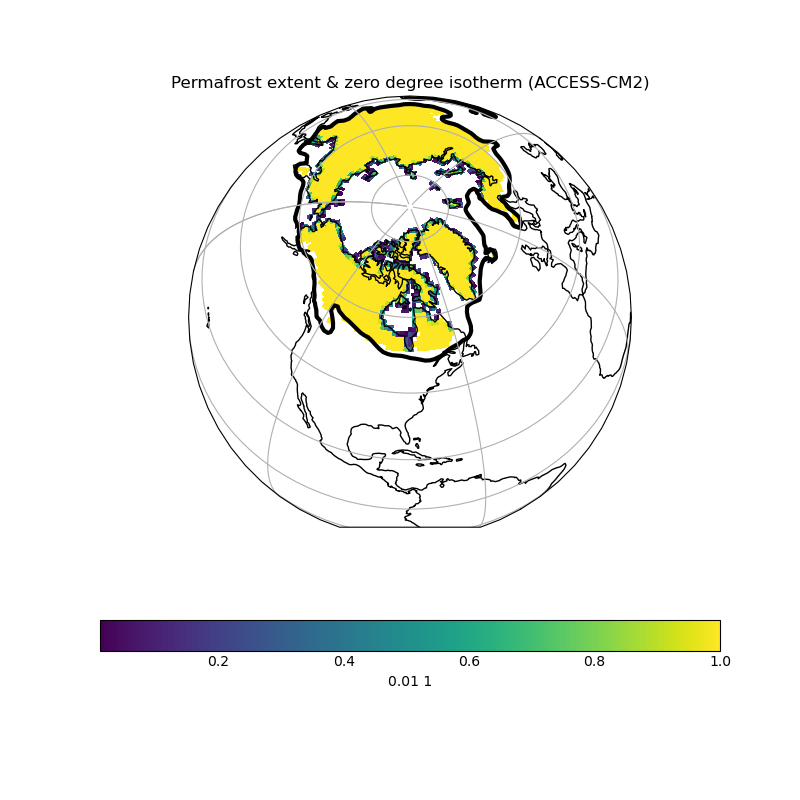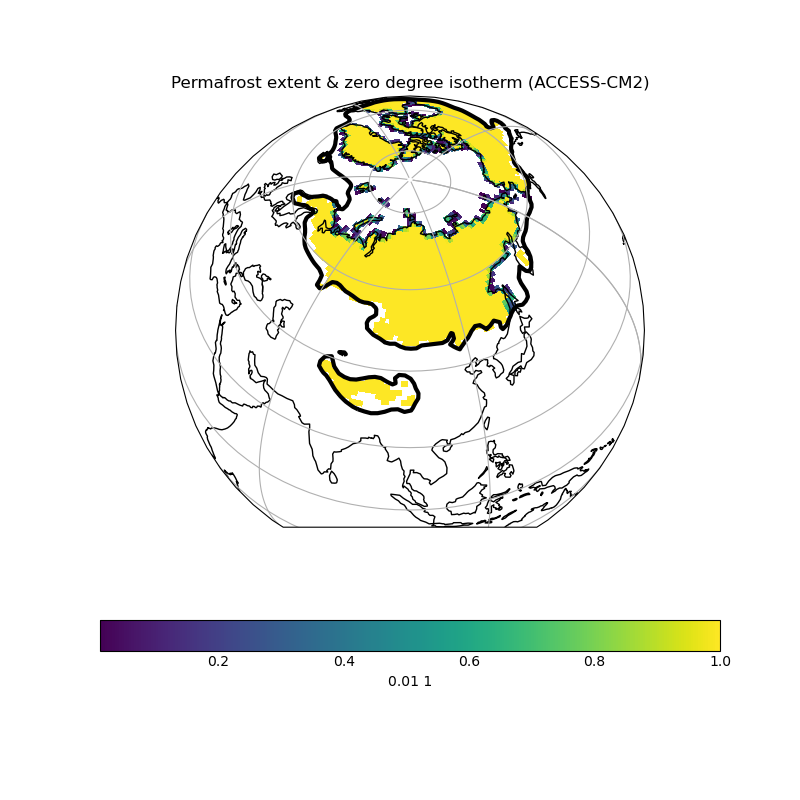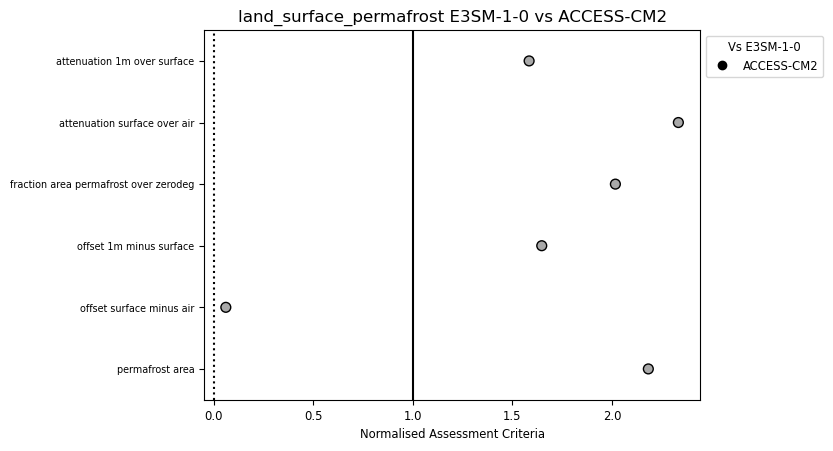Land-surface Permafrost - Autoassess diagnostics#
Overview#
Permafrost thaw is an important impact of climate change, and is the source of a potentially strong Earth system feedback through the release of soil carbon into the atmosphere. This recipe provides metrics that evaluate the climatological performance of models in simulating soil temperatures that control permafrost. Performance metrics (with observation-based estimates in brackets):
permafrost area (17.46 million square km)
fractional area of permafrost northwards of zero degree isotherm (0.47)
soil temperature at 1m minus soil temperature at surface (-0.53 degrees C)
soil temperature at surface minus air temperature (6.15 degrees C)
annual amplitude at 1m / annual amplitude at the surface (0.40 unitless)
annual amplitude at the surface / annual air temperature (0.57 unitless)
Plots:
Maps of permafrost extent and zero degC isotherm
Normalised assessment metrics plot comparing control and experiment
The recipe takes as input a control model and experimental model, comparisons being made with these two models.
Available recipes and diagnostics#
Recipes are stored in esmvaltool/recipes/
recipe_autoassess_landsurface_permafrost.yml
Diagnostics are stored in esmvaltool/diag_scripts/autoassess/
autoassess_area_base.py: wrapper for autoassess scripts
land_surface_permafrost/permafrost.py: script to calculate permafrost metrics
plot_autoassess_metrics.py: plot normalised assessment metrics
User settings in recipe#
Script autoassess_area_base.py
Required settings for script
area: must equal land_surface_permafrost to select this diagnostic
control_model: name of model to be used as control
exp_model: name of model to be used as experiment
start: date (YYYY/MM/DD) at which period begins (see note on time gating)
end: date (YYYY/MM/DD) at which period ends (see note on time gating)
Optional settings for script
title: arbitrary string with name of diagnostic
obs_models: unused for this recipe
Required settings for variables
none
Optional settings for variables
none
Script plot_autoassess_metrics.py
Required settings for script
area: must equal land_surface_permafrost to select this diagnostic
control_model: name of model to be used as control in metrics plot
exp_model: name of model to be used as experiment in metrics plot
title: string to use as plot title
Optional settings for script
none
Required settings for variables
none
Optional settings for variables
none
Variables#
tas (atmos, monthly mean, longitude latitude time)
tsl (land, monthly mean, longitude latitude time)
mrsos (land, monthly mean, longitude latitude time)
sftlf (mask, fixed, longitude latitude)
Observations and reformat scripts#
None
References#
Observed permafrost extent is from http://nsidc.org/data/ggd318.html: Brown, J., O. Ferrians, J. A. Heginbottom, and E. Melnikov. 2002. Circum-Arctic Map of Permafrost and Ground-Ice Conditions, Version 2. Boulder, Colorado USA. NSIDC: National Snow and Ice Data Center. When calculating the global area of permafrost the grid cells are weighted by the proportion of permafrost within them.
Annual mean air temperature is from: Legates, D. R., and C. J. Willmott, 1990: Mean seasonal and spatial variability in global surface air temperature. Theor. Appl. Climatol., 41, 11-21. The annual mean is calculated from the seasonal mean data available at the Met Office.
The soil temperature metrics are calcuated following: Charles D. Koven, William J. Riley, and Alex Stern, 2013: Analysis of Permafrost Thermal Dynamics and Response to Climate Change in the CMIP5 Earth System Models. J. Climate, 26. (Table 3) http://dx.doi.org/10.1175/JCLI-D-12-00228.1 The locations used for Table 3 were extracted from the model and the modelled metrics calculated.
Example plots#

Fig. 67 Permafrost extent and zero degC isotherm, showing North America#

Fig. 68 Permafrost extent and zero degC isotherm, showing Asia and Europe#

Fig. 69 Normalised metrics plot comparing a control and experiment simulation#
Additional notes on usage#
The landsurface_permafrost area metric is part of the esmvaltool/diag_scripts/autoassess diagnostics,
and, as any other autoassess metric, it uses the autoassess_area_base.py as general purpose
wrapper. This wrapper accepts a number of input arguments that are read through from the recipe.
This recipe is part of the larger group of Autoassess metrics ported to ESMValTool
from the native Autoassess package from the UK’s Met Office. The diagnostics settings
are almost the same as for the other Autoassess metrics.
Note
Time gating for autoassess metrics.
To preserve the native Autoassess functionalities,
data loading and selection on time is done somewhat
differently for ESMValTool’s autoassess metrics: the
time selection is done in the preprocessor as per usual but
a further time selection is performed as part of the diagnostic.
For this purpose the user will specify a start: and end:
pair of arguments of scripts: autoassess_script (see below
for example). These are formatted as YYYY/MM/DD; this is
necessary since the Autoassess metrics are computed from 1-Dec
through 1-Dec rather than 1-Jan through 1-Jan. This is a temporary
implementation to fully replicate the native Autoassess functionality
and a minor user inconvenience since they need to set an extra set of
start and end arguments in the diagnostic; this will be phased
when all the native Autoassess metrics have been ported to ESMValTool
review has completed.
An example of standard inputs as read by autoassess_area_base.py and passed
over to the diagnostic/metric is listed below.
scripts:
plot_landsurf_permafrost: &plot_landsurf_permafrost_settings
<<: *autoassess_landsurf_permafrost_settings
control_model: MPI-ESM-LR
exp_model: MPI-ESM-MR
script: autoassess/plot_autoassess_metrics.py
ancestors: ['*/autoassess_landsurf_permafrost']
title: "Plot Land-Surface Permafrost Metrics"
plot_name: "Permafrost_Metrics"
diag_tag: aa_landsurf_permafrost
diag_name: autoassess_landsurf_permafrost
